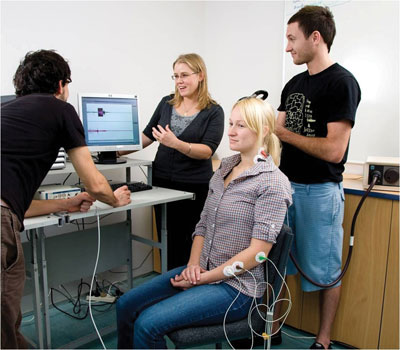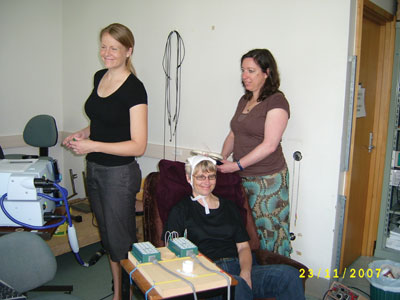
The Australian Spinal Research Foundation, now referred to as Spinal
Research, was born out of a desire to see chiropractic care play a major
role in health care.
The Australian Spinal Research Foundation, now referred to as Spinal Research, was born out of a desire to see chiropractic care play a major role in health care.
 |
|
| Dr. Heidi Haavik (standing, middle) and her team study the impact of chiropractic care on position sense. Photos courtesy of Australian Spinal Research Foundation Advertisement
|
More than 30 years ago, a group of committed members of the Australian Chiropractors Association realized two things:
First, research into chiropractic has a vital role to play in partnering with practice and academia to grow certainty within the chiropractic profession; the goal is to allow the profession to reach more people and be a first-choice health-care option. And second, the profession itself must take a leadership role in funding that research.
ABOUT US
Spinal Research (SR) is a non-profit organization facilitating research that is unique to the chiropractic paradigm.
 |
|
| Dr. Bernadette Murphy (right) and her team performing neurophysiology studies.
|
As DCs, we think differently about life and human potential. We believe that people deserve a healthy, happy, active life and that chiropractic helps them achieve it. We recognize the value of the chiropractic adjustment. Our vision is to demonstrate, through scientific evidence, that having regular chiropractic care helps people live healthier, happier lives. This is why we focus on research that investigates the effects of the chiropractic adjustment on human function and global well-being.
STUDIES FUNDED BY SR
To better convey a sense of the sort of research I am describing, I will review the studies we have funded through Spinal Research’s last few funding rounds:
- A study led by Prof. Phillip Bolton at the University of Newcastle. He is using an animal model to see if an induced vertebral subluxation in rats causes changes in spinal cord function and causes cord compression.
- A study by Dr. Kelly Holt and his colleagues at New Zealand College of Chiropractic (NZCC). This team is looking at the possible effects of chiropractic care on sensorimotor integration and risk of falls. One of the biggest predictors of a loss of quality of life in older people is a fall. A fall in an older person is associated with large increases in their risk of morbidity and mortality. In people over the age of 65, 80 per cent of injury-related hospital admissions are caused by falls and they are the leading cause of injury-related death. They lead to loss of independence. They lead to depression. They lead to lowered quality of life.
The proportion of the population over 65 is expected to double in the next 50 years and the costs of falls is expected to be more than 30 billion dollars in the U.S. by 2020.
The research literature shows that falls often happen in association with a decline in nervous system function with aging. This study addresses the potential difference that chiropractic could make here. Could we deliver on our promise to “add years to your life and life to your years?” - Another study funded at NZCC, carried out by Dr. Heidi Haavik and her team. Dr. Haavik et al. used neurophysiology-testing approaches to discover whether 12 weeks of chiropractic care leads to long-lasting changes in the ability of the brain to process incoming information. Their results show that chiropractic adjustments do create long-lasting changes in brain function.
- A study by Dr. Barbara Polus and her team at the Royal Melbourne Institute of Technology. This work involves developing a testable model of subluxation using the property of muscle function called thixotropy to better understand how subluxation may affect the nervous system.
- Dr. Bernadette Murphy and her team have been funded to undertake a study looking at the effect of chiropractic adjustments on pelvic floor muscle function. Many chiropractors notice that women under their care seem to have easier labours with fewer complications, fewer issues with incontinence and better core stability.
Pelvic floor muscle function is incredibly important for many reasons. Having co-ordinated, synchronous muscle function is important in labour (particularly in the pushing stage) in maintaining continence and in maintaining core stability along with activation of the abdominal muscles.
This study will investigate whether adjusting lumbopelvic vertebral subluxations changes pelvic muscle function. - Dr. Heidi Haavik has also been funded to undertake a study looking at the impact of chiropractic care on joint position sense. Joint position sense is a measure of how well your brain is processing information. The results show that adjustments, even when you don’t have symptoms, can improve nerve function.
- Another study for which Prof. Phillip Bolton has received funding looks at the central role that chiropractic places on the sympathetic nervous system. This study uses a new technology called micro-neurography to directly measure the effects of adjustments on sympathetic outflow.
- Brain-derived neurotrophic factor (BDNF) in the brain is a protein that is associated with learning and memory. Reduced levels of BDNF are associated with Alzheimer’s disease, Huntington’s disease, depression and schizophrenia. Spinal Research has funded Prof. Phillip Bolton to carry out an animal study looking at the effect of chiropractic care on BDNF levels.
- Dr. Chris Colloca is collaborating with researchers from the Adelaide Centre for Spine Research along with a Belgian orthopedic surgeon. Spinal Research has funded this group to look at the effects of chiropractic adjustments on sympathetic nervous system function in a sheep model.
So what does all this mean?
As a profession, we have taken too long to produce too little – we cannot sustain the profession by maintaining the status quo when health reform is rampant, globally. We recognize that there are many individuals and interest groups with different viewpoints about the profession. We also recognize a common orientation exists around the chiropractic paradigm and the need for research to provide the evidence to:
- support efforts in lobbying for the profession in relation to health policy,
- advocate for chiropractic in public relations,
- inform teaching institutions and
- empower chiropractors to take better care of people and take care of more people.
The Australian Spinal Research Foundation (Spinal Research) is seeking out and reaching out, inviting chiropractors and their associations to make a difference by supporting more research to be accomplished at a faster rate. Those involved in politics, research, teaching institutions and public relations for the profession can participate and lobby government, influence health policy and get positive PR for chiropractic if they are supported by a base of solid research.
The profession needs those who have a stake in chiropractic to participate. We need a partnership of all parties, all skills and all resources – a chiropractic research partnership.
Dr. Martin Harvey is inspired by the potential that chiropractic care has to transform the health of our communities in a cost-effective, efficient and safe manner. He is the current president of the Australian Spinal Research Foundation, a sought-after speaker and leads a multi-doctor wellness practice in Melbourne. Martin was awarded Parker Seminars “2010 International Chiropractor of the Year”, has received many “Outstanding Service Awards” from the Chiropractors Association of Australia. He was honoured as an inaugural Member of the Australasian College of Chiropractors. Since graduating in 1992, he has served the chiropractic profession on the boards of the Chiropractors Association of Australia (Vic), Chiropractic Education Australia and Spinal Research.
Print this page